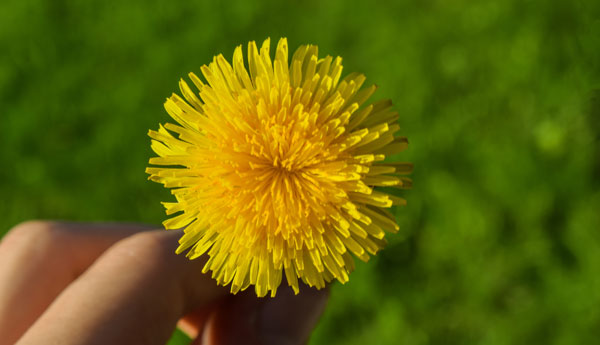
One of the most important things about making the jump into homesteading, is learning to look at the world through a different lens. You see, when you’re trying to live fully self-sufficient, there’s much less room for waste, and the multiple uses of things become more readily apparent. Likewise, things you once may have considered fully useless, or even actively tried to rid yourself of, may now have their true utility come to light. Such is the case with the humble dandelion. The bane of homeowners and lawn aficionados everywhere, dandelions may be the most hated piece of vegetation in history, with a vast array of killers and poisons designed specifically to root out this resilient weed. This year, however, try leaving those dandelions, and use their fluorescent flowers to add a sweet, cooling touch to your summer evenings, with a nice bottle of dandelion wine.
Dandelion wine truly does capture the sweet soul of summer. With floral, honied notes, the wine has been a staple of rural living for many years, and is actually quite simple to make, if you have the time. For starters, you’ll need quite a few dandelions, so be ready to do some picking. While depending on the number of dandelions you have around, you can pick enough for a traditional five-gallon run in about an hour, the work does not stop there. Once the dandelions are picked, you’ll need to strip off the yellow petals from the green leaves below. Only the petals are useful for making the wine you see, as the leaves and stem contain a sap not too dissimilar from milkweed, which will leave a bitter taste. Of course, a small amount that gets by your careful fingers won’t be enough to spoil the batch. To make just under a gallon, therefore, you’ll need about two quarts of dandelion flowers. Once these are collected and separated, the fun can begin.
Place the flowers in a glass receptacle (certain types of metal can vary the taste a bit, so glass is a nice rule of thumb), then take a gallon of water, bring it to boil and pour it over the flower petals, where it should sit around two hours. Through a cheesecloth-lined colander, strain out the flower mixture into another pot, making sure to squeeze the flower paste itself, which will have absorbed a fair amount of liquid. The flowers can now be discarded, as you bring the dandelion-infused water to boil.
Once boiling, stir in a pound to a pound-and-a-half of sugar. While this will add sweetness, its main purpose is to aid in the fermentation process: the more sugar, the faster and more intense the fermentation. At this time, you can also add in any citrus juices to enhance the flavor. My favorite accents are lemons, usually using two to four, or peaches, of which you rarely need more than two. If just using lemons, a couple oranges can also make a nice complementary flavor. Once the meal has cooled to under 90 degrees, stir in a tablespoon or two of cornmeal, and a half-teaspoon of baking yeast. From here, cover the mixture for two weeks, stirring several times a day (I generally stir five times, though this part is more art than science).
After sitting for this period, siphon the wine into a gallon jug, or carboy if you have one, careful to leave any solids behind. Seal this with an airlock, which you can either purchase online, or make yourself. While I would recommend purchasing one, I made my first one out of a straw, some glue and an old film canister, instructions for which can be found here. After three weeks, you will siphon the wine again into another air-locked receptacle, repeating the process. This is termed, “racking.” Once the wine clears, wait about a month, then rack the wine back into another airlock. From here, the process becomes up to you. As the old saying goes, “the longer it sits, the better it gets,” so you could continue the previous steps, racking every three months, until there is no sediment left (generally takes around ten months total). From there, you even have the option to age the wine another year. This will produce a smooth wine worthy of a blue ribbon at your county fair. If you’re the thirsty sort however, and aren’t out to impress anyone, you can make the wine in far less time. In fact, after that first racking, all you really need to do is wait until the bubbles stop, which generally takes about two weeks, before you strain the liquid into bottles, cork, and let sit for at least a week before drinking. My advice? Make two gallons, and do one of each–a quick one for drinking this summer, and a prize batch to let sit. Do this every year, and after the first two, you’ll have a prize batch of dandelion wine to look forward to every single summer. Cheers to summer evenings enjoyed right!
A humble homesteader based in an undisclosed location, Lars Drecker splits his time between tending his little slice of self-sustaining heaven, and bothering his neighbors to do his work for him. This is mainly the fault of a debilitating predilection for fishing, hunting, camping and all other things outdoors. When not engaged in any of the above activities, you can normally find him broken down on the side of the road, in some piece of junk he just “fixed-up.”

Jesse Tiede says
My dad used to make this stuff when I was a kid. Unfortunately, I was too young to taste test it, but my brother, who was 6 years older than me, often got to sample it, especially after he came home from Vietnam. I just might try this…